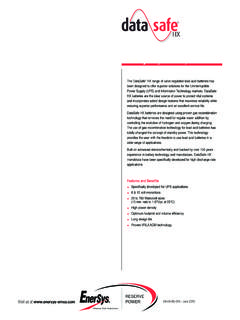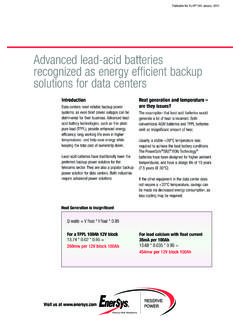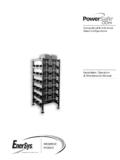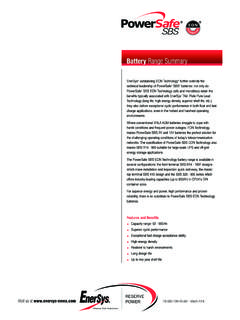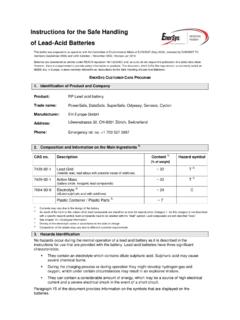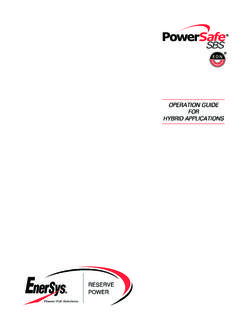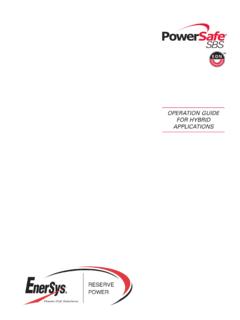Transcription of RESERVE POWER - EnerSys
1 INSTALLATION, OPERATION& MAINTENANCE MANUALRESERVEPOWEROld batteriesbearing this signare notreturned forrecycling must be disposed ofas special waste inaccordance with and Safety Warnings22 Cell Identification33 Unpacking34 Storage35 Installation Instructions46 Filling with Acid57 Commissioning Charge58 General Battery ChargingRequirements69 Adjustment of Specific Gravity 610 Battery Discharge TestingProcedure711 Service Instructions712 Torque Settings713 Isolation Connectors forHigh Voltage Batteries814 Diagnosis of BatteryCondition8 Appendix I9 Appendix II10 Batteries are often the last lines ofdefence in
2 Providing electrical energyafter failure of the mains supplies four types of ventedlead acid PowerSafe Plant cellsdescribed in this publication. AllPowerSafe Plant cells meet therequirements of BS EN 60896-11 andBS6290 Part manual provides the user withinformation for optimising performanceand service information contained in thismanual should be read in conjunctionwith EN 50272 and BS should also be made to theappropriate Health & Safety Data Sheet,a copy of which is available are only valid if the producthas been installed, operated andmaintained in accordance with Scope and Safety WarningsPlant batteries are hazardous.
3 Take note of the meanings of the following symbolsand smoking! No nakedflames!No sparks! Risk of explosion.(1) No Smoking(8) SulphuricAcid(2) ContainsexplosivegasesElectrolyte is highly corrosivesulphuric acid!Flush any acid splashes fromeyes and off skin with plentyof clean water. Seek medicalaid clothing shouldbe washed in water withminimum of explosion and fire!Avoid short circuits. Neverplace metal tools or otherobjects on batteries as theyare always wear safety glassesand protective with accidentprevention regulations andyour national Health andSafety standards.(3) Shield eyes(4) Noteoperatinginstructions(5) Keep awayfrom childrenObserve instructions for useof the battery and ensurethey are visibly prominentnear the weights!
4 Take carewhen transporting, liftingand installing batteries.(6) Danger(7) ElectricalHazard(9) Recycle/PbElectrical Hazard!Batteries are always Risk analysisThe immediate risks are electrical energy, ignition of gases,sparks from short circuits, chemical burns from the electrolyteand Energy Electrical energy can be supplied from both batteries andcharging equipment. Use acid resistant insulated tools and remove or insulate allmetallic items worn about the person. Protect the eyes by wearing safety spectacles. Minimise the number of conductors exposed at any onetime. Use temporary insulation if connectors are notinsulated.
5 On high voltage batteries break the battery down intosections of 60 cells or less and never work of gases Prevent ignition of gases from the battery. Never permit smoking, sparks or any kind of flames near thebattery. Isolate circuits before connection or disconnection of testloads or chargers. Ensure that ventilation maintains the concentration ofhydrogen gas below the explosive Burns Before starting work ensure that a supply of water, eye washstations, and a first aid kit is available. The eyes and face should be protected. For general inspection and maintenance, boiler suit,eye protection, and rubber gloves should be worn.
6 When filling a cell with electrolyte, a plastic apron and rubberboots should also be worn. In case of electrolyte burns, wash affected areas with lots ofcold water. If electrolyte gets into eyes, rinse with eyewash. In all cases, seek immediate medical Cells can be very heavy and awkward to handle. The terminal pillars should not be used to lift cells. Lifting devices should be designed such that they do notcause short circuits across the terminal Spillage Electrolyte spills should be contained and acid should not be allowed to enter the For the batteries health and safetyA battery is normally the last line of defence against systemfailure and maintenance routines should reflect this.
7 Ensure that the battery charging system is operatingcorrectly. When topping up add only de-ionised water. Never add anykind of sulphuric acid. Keep the battery clean, coat connectors with grease andensure correct fastener tightness. Apply equalising charges as appropriate to maintain thecorrect state of Electromagnetic compatibility Rechargeable cells or batteries are not sensitive to normalelectromagnetic disturbances and therefore no immunitytests are Cell IdentificationThe cells are provided with the following identification: The cell type ( YAP13) together with MAX and MINelectrolyte level indication is included on the product label.
8 Colour coded Positive (red) and Negative (blue) pillar ringsidentify month and year of manufacture. Cells supplied filled and charged have a barcode label givingindividual cell serial number together with date of initialfilling and UnpackingAll items should be carefully checked against theaccompanying advice notes to determine if any are should be inspected for damage and for cells suppliedfilled and charged, the terminal voltage measured to ensurethat none are below Volts per cell. If any are below thisvalue, or if any items are missing, damaged or broken theCompany should be notified at is normal for the electrolyte level of products supplied in afilled and charged condition to be a little below the maximumlevel.
9 This occurs because gas bubbles created during initialcharging are not always dispersed before dispatch but duringtransit. However, if on opening the package there is obviousindication of acid spillage, the affected cells should be toppedup with dilute acid to the recommended electrolyte level, thecells should be inspected for transit damage and the faultreported to EnerSys .Product supplied filled and charged will have an electrolytespecific gravity below that for fully charged cells because ofself-discharge occurring after initial factory StorageIf the battery is not to be used immediately, certain criteriamust be observed for it to remain in good condition.
10 Cellsshould be stored in a clean and dry environment withtemperature as moderate as the climate will allow. Cells mustnot be stored in direct maximum period for which the product can be storeddepends on the condition in which it is Storage times for cells supplied dry chargedTypical storage times are: 12 months up to 20 C 6 months up to 30 C 3 months up to 40 CThese storage times are applicable to a relative humidity of50%. Storage times are progressively reduced to half thatstated at a relative humidity of 100%.4If the storage times and/or temperature limits are exceeded,the product may lose its dry charged characteristics andbecomes described as time expired dry charged.
